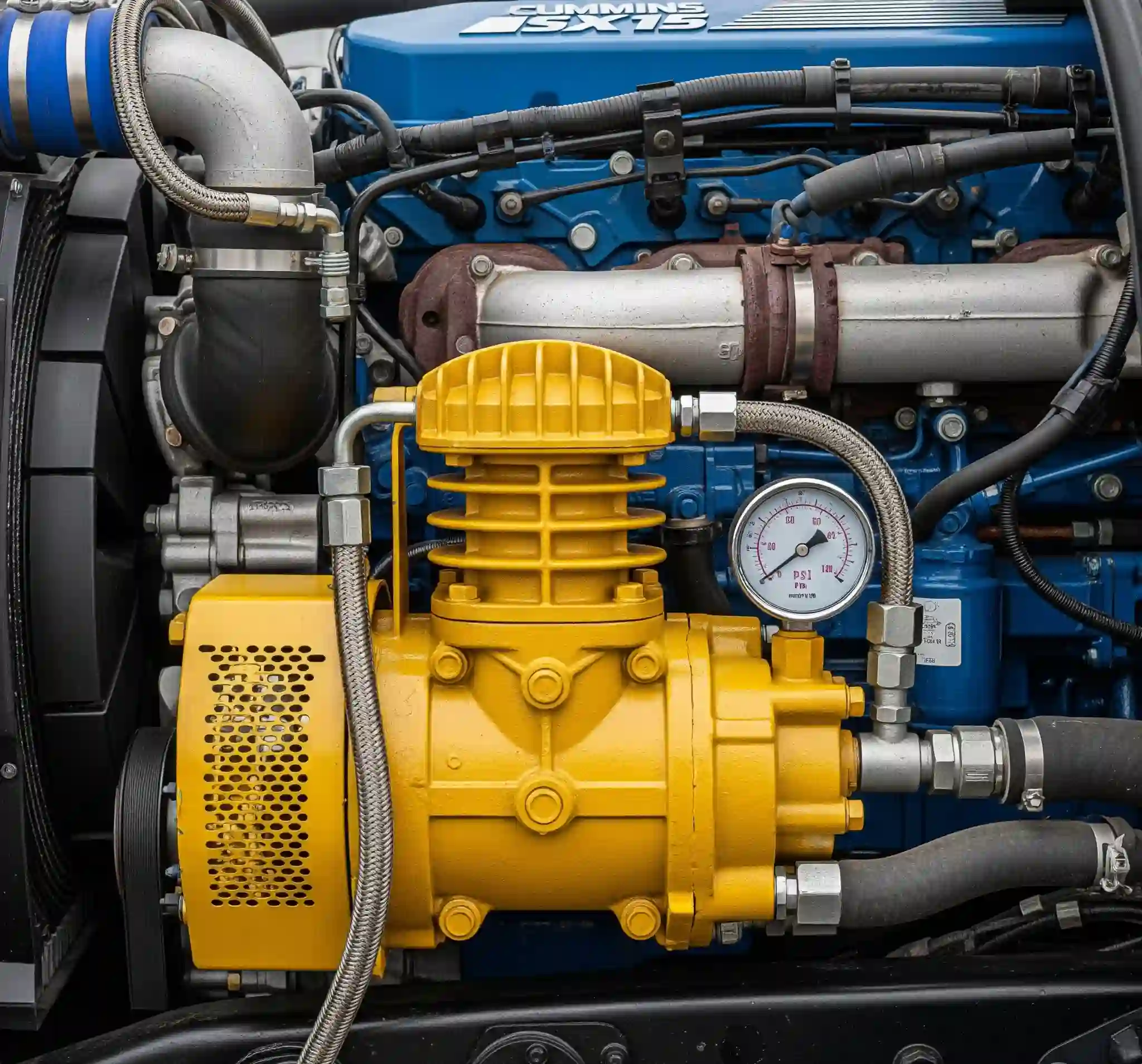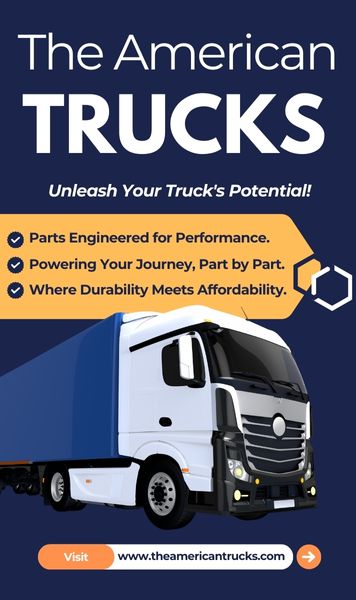
The Heartbeat of Safety: A Complete Guide to Air Brake Components in Your Rig
The sheer power of an American truck is a marvel of modern engineering. But for every ounce of horsepower dedicated to moving tons of cargo forward, there must be an equal, unwavering force dedicated to bringing it to a safe stop. That force is the air brake system—a complex network of components working in perfect harmony. A failure in any single part of this system can have catastrophic consequences.
At The American Trucks, we don’t just manufacture parts; we build confidence. We understand that drivers, mechanics, and fleet managers stake their safety and livelihood on the reliability of every valve, chamber, and line. This is why we believe a deep understanding of the system is paramount. This guide will walk you through the critical Air Brake Components, with a special focus on one of the system’s most vital guardians: the air dryer.
The Power Source The Air Compressor and Governor
Every air brake system begins with the air compressor. Typically driven by the truck’s engine, its sole purpose is to draw in outside air and pressurize it, acting as the heart that pumps life into the system. As it runs, it builds air pressure up to a level determined by the governor.
The governor is the brain of the compression operation. It senses the pressure in the air tanks and tells the compressor when to work (the “cut-in” pressure, often around) and when to rest (the “cut-out” pressure, typically). When the system is full, the governor signals the compressor to enter an “unloaded” stage, where it simply circulates air without building more pressure, saving fuel and reducing wear.
However, the compression process has an unavoidable side effect: it generates immense heat. This heat allows the compressed air to hold a large amount of water vapor drawn from the atmosphere, along with trace amounts of oil from the compressor’s own lubrication. This hot, wet, oily air is poison to the rest of the brake system, which brings us to the system’s unsung hero.
The Guardian Why Air Dryers and Parts are Non-Negotiable
If the compressor is the heart, the air dryer is the kidney. Its job is to filter out the harmful contaminants—water and oil—before they can wreak havoc on downstream components. Operating a truck without a properly functioning air dryer is a gamble no one should take.
The Dangers of Contaminated Air:
- Corrosion and Sludge: When water and oil mix, they form a thick, acidic sludge. This sludge corrodes the inside of steel air tanks, gums up the moving parts of valves, and degrades rubber seals and diaphragms.
- Winter Freeze-Ups: In cold weather, collected water can freeze inside air lines or valves. A frozen valve can fail in any position—stuck open or stuck closed—leading to dragging brakes or, far worse, brakes that won’t apply at all.
- Valve Failure: Modern air brake systems rely on highly sensitive components like ABS (Anti-lock Braking System) modulator valves. These precision parts are extremely intolerant of contamination. Sludge and moisture can cause them to malfunction, leading to costly diagnostics and repairs, not to mention compromising the ABS safety feature.
How the Air Dryer Works its Magic:
The familiar, sharp “pssh” sound an air truck makes is the sound of the air dryer actively protecting the brake system. This process involves two main cycles:
- The Charging Cycle (Adsorption): As hot, wet air leaves the compressor, it enters the air dryer. Here, it is forced through a cartridge filled with a desiccant material—a collection of porous beads designed to attract and hold water molecules on their surface (a process known as adsorption). Some advanced cartridges also have a coalescing filter element that removes oil. The result is that clean, dry air exits the dryer and flows to the air tanks, ready for use.
- The Purge Cycle (Regeneration): The desiccant can only hold so much water. It must be “cleaned” to remain effective. When the air system reaches the governor’s cut-out pressure, the governor sends a signal that simultaneously unloads the compressor and opens a purge valve at the bottom of the air dryer. This instantly vents the pressure from the desiccant cartridge. A small amount of perfectly dry air from a dedicated “purge tank” (or drawn back from the primary tank) is then flushed backward through the desiccant. This rapid depressurization and back-flow blast the collected water and oil out through the purge exhaust port, creating that signature “pssh!” This regenerates the desiccant, making it ready for the next cycle.
Essential Air Dryer Parts:
Understanding the individual Air Dryers and Parts is key to proper maintenance.
- Desiccant Cartridge: This is the core consumable component. It has a limited service life (typically 1-3 years) and must be replaced regularly.
- Purge Valve: This electro-pneumatic or purely pneumatic valve is the active component in the purge cycle. Failures can lead to it sticking open (preventing air from building) or leaking (causing the dryer to cycle too frequently).
- Heater Assembly: For rigs operating in colder climates, a or heater is crucial. It wraps around the purge valve and activates via a thermostat (often below `) to prevent the purged moisture from freezing and blocking the exhaust.
- Check Valves & Gaskets: Internal check valves direct airflow correctly, while external gaskets ensure a leak-free seal.
At The American Trucks, we manufacture a complete line of premium Air Dryers and Parts, from spin-on coalescing cartridges to complete purge valve repair kits, ensuring you can keep this vital system guardian in peak condition.
Storage and Distribution Air Tanks and Valves
Once the air is clean and dry, it needs to be stored and controlled.
- Air Tanks (Reservoirs): A truck has multiple air tanks, creating a redundant system for safety. The first tank after the dryer is often called the “wet tank,” offering a last chance for any residual moisture to condense before air moves to the “dry” tanks. These dry tanks are split into primary and secondary circuits. One circuit typically controls the rear axle brakes, and the other controls the front axle brakes. This ensures that a leak in one circuit won’t cause a total loss of braking ability.
- Safety Valve: Every air tank is equipped with a safety pop-off valve (usually set around) to protect the tank from over-pressurization in case of a governor failure.
- Treadle Valve (Foot Valve): This is the driver’s direct interface with the brake system. When you press the brake pedal, you are actuating the treadle valve. It releases a controlled amount of air from the tanks, proportional to how hard you press the pedal. This signal of air pressure is then sent out to control the rest of the system.
- Relay and Quick Release Valves: To overcome the lag of sending air all the way to the rear axles, relay valves are installed closer to the brake chambers. The treadle valve sends a small, fast-moving air signal to the relay valve, which then opens and delivers a large volume of air from a nearby tank directly to the brake chambers, speeding up brake application. Quick release valves perform the opposite function, allowing air to be vented quickly near the chamber for faster brake release.
The Final Act Chambers and Foundation Brakes
The final stage is where air pressure is converted into the mechanical force that stops the truck.
- Brake Chambers: These round metal cans mounted at each wheel end are the muscles of the system. Each one contains a rubber diaphragm. When you apply the brakes, air pressure pushes on this diaphragm, which in turn pushes a rod out of the chamber. Most drive and trailer axle chambers are dual-circuit spring brakes. One half is the service brake (applied with air pressure), while the other half contains a massive internal spring. This spring is held compressed by constant air pressure when you are driving. If you lose air pressure, or when you pull the parking brake knob, the air is released, and the powerful spring applies the brakes. This is the system’s primary safety/emergency feature.
- Slack Adjusters: The pushrod from the brake chamber connects to a lever called a slack adjuster. This lever’s job is to take up the “slack” or gap between the brake shoes and the brake drum. Most modern trucks use automatic slack adjusters that self-adjust during full brake applications to maintain the correct clearance.
- S-Cam, Shoes, and Drums: The slack adjuster rotates a shaft with an S-shaped cam at the end. As the S-cam turns, its lobes push the brake shoes outward against the inner surface of the cast-iron brake drum, which is rotating with the wheel. This friction is what generates the immense stopping force required.
Trust The American Trucks for Every Component
As you can see, the air brake system is an elegant but demanding chain of components. The integrity of the entire system relies on the quality of each individual part. A failing air dryer can lead to a faulty relay valve, which can lead to delayed braking. A leaky diaphragm in a brake chamber can drain system pressure, causing the compressor and dryer to overwork.
For this reason, settling for subpar components is not an option. At The American Trucks, we are committed to providing the highest quality Air Brake Components on the market. From our robust compressors to our precision-engineered S-cams and our industry-leading Air Dryers and Parts, every product is designed for maximum safety, durability, and performance.
Protect your vehicle, your cargo, and yourself. Explore our full catalog of parts and trust The American Trucks to deliver the stopping power you depend on.




